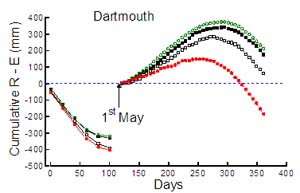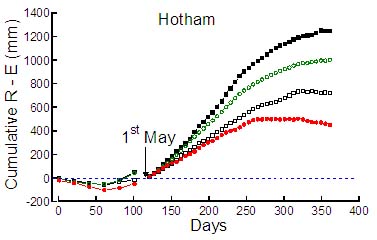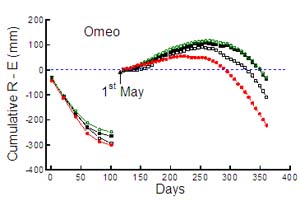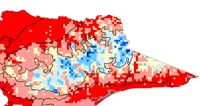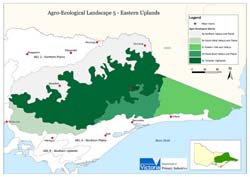Primary Production Landscapes Home
Land use
Eastern Victoria has extensive native forests, parks and production forestry. Conservation and forestry are the largest (72%) land uses of the Eastern Uplands. Private land/leasehold (18%) is primarily used for production for dryland agriculture including grazing. 37% of Victorias intensive land uses including dairy and horticulture occur in this region. Primary production occurs on the fringes of the highlands in the cleared valleys and plains. | |
Primary Production Landscapes
Northern Valleys and Plains
Shallow to deep gradational soils are located on inter-montane valleys and hills. Rainfall is generally high while land uses include dairy, forestry, horticulture and grazing.
South-West Valleys and Plains
These valleys and plains occur on the eastern fringe of Melbourne with land uses including viticulture, grazing and lifestyle farming. Climatic conditions are temperate to montane with low evaporation compared to plains further west.
Eastern Hills and Valleys
High to moderate yearly rainfall is influenced by climatic patterns from the north (NSW). Granitic and sedimentary mountains, hills and valleys are largely conservation parks and forests with grazing located along valley floors and floodplains.
South-East Valleys and Plains
Weathered granitic terrain with surrounding sedimentary slopes and basins experience significantly less rainfall (rain shadow) than neighbouring regions. Grazing (beef cattle) is the major land use.
Victorian Highlands
The highest elevation terrain in Victoria experiences very high rainfall and seasonal snow coverage. Plateaux, ridges and mountains are used for conservation and eco-tourism purposes. | |
| Management practices and issues in response to Climate Change
Mixed farming systems
- The growing season for pastures and crops has shortened with disappearance of the autumn break. Reduced rainfall and a shorter growing period has degraded perennial pasture systems, producing poorer quality feed for livestock. Lucerne isn’t always filling this feed gap as there are soil constraints that affect its growth.
- Interest is growing in short-term crops to fill feed shortages. Cropping has benefited from drier soils and seasons that aren’t as prone to waterlogging. Cropping was used mainly in pasture renovation and is now used more frequently in the farming system.
- Wild dogs and their impact on livestock have forced movement of livestock away from upland areas to reduce stock losses.
- Farm labour shortages for shearers and farm hands represent an ongoing limitation to mixed farming systems.
- Purchase of land for amenity lifestyle farming has significantly increased regional land prices.
- Distance to major markets and the price of diesel remains an issue for livestock and grain producers.
- Increasing interest in pasture systems including native pastures could see a return to low input systems. Traditional farming approaches including biological farming in response to fertiliser, seed and spray prices are gaining interest.
- Public forestry is mainly confined to valley slopes. A decline in the number of timber and pulp mills to process wood from these plantations could result in vast quantities of wood transported from the region to be processed.
|
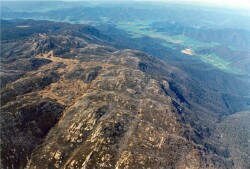 Aerial view of Mt Buffalo Aerial view of Mt Buffalo |
Dairy farming systems
- Dairy farming is struggling to remain sustainable in hill country where perennial pasture production has declined through rapidly degrading pastures. Presently pastures are renovated every 5 years.
- Calving has moved to earlier in the year, allowing greater flexibility in response to drier slopes with less available feed.
- Transport and fuel costs remain issues for isolated dairies near Corryong and in valleys north and south of the divide.
Future scenarios for farming systems
- Water availability for irrigated pastures is a major future issue for continued livestock production (particularly irrigated dairy).
- Grazing with beef cattle is expected to persist in drier climatic conditions while continued decline is expected for wool and prime lamb production.
- Primary producers are looking for flexibility in farming systems to benefit from good seasons and reduce risk in poor ones.
- Production rates will likely decline for softwood and hardwood plantations.
|

Cows on irrigated pasture |
Victoria’s changing climate
Mean annual temperature (two scenarios from past records and one predicted scenario)
1970-1995 | 1996-2005 | 2050 A1FI prediction |
| | |
|
1970-1995 | 1996-2005 | 2050 A1FI prediction |
| | |
|
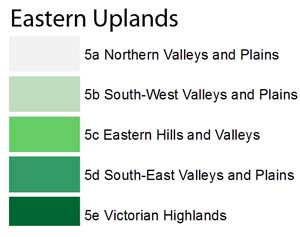
 Aerial view of Mt Buffalo
Aerial view of Mt Buffalo
